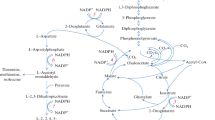Summary
During the homolactic fermentation of glucose by Lactobacillus plantarum the concentration of pyruvate rises temporarily to 120 mg/l.
By the addition of thiamine, this concentration is reduced to 10–20 mg/l. The subsequently intensified turnover of pyruvate leads to the doubling of acetoin synthesis. This is reasonable since thiamine is a cofactor of the acetohydroxy acid synthetase, too.
When thiamine and lipoic acid are added simultaneously, again a doubling of acetoin synthesis occurs, while lipoic acid alone has no effect. This may be explained by an additional synthesis of acetoin via acetyl-CoA to diacetyl and further reduction to acetoin.
The rapid changes in the concentrations of pyruvate and acetoin following the addition of thiamine during the logarithmic growth phase may be explained by the activation of one or more of the acetoin synthesizing enzymes.
A feedback inhibition of acetoin synthesis by valine and isoleucine was not detected.
Zusammenfassung
Das homofermentative Milchsäurebakterium Lactobacillus plantarum weist während der Glucosevergärung einen zeitweiligen Pyruvatstau von 120 mg/l auf, der durch Thiaminzugabe auf 10–20 mg/l reduziert werden kann. Der hierdurch intensivierte Pyruvatdurchsatz bedingt eine Verdoppelung der Acetoinsynthese, da Thiamin auch Cofaktor der Acetolactat-Synthetase ist. Ein gleichzeitiger Thiamin- und Liponsäurezusatz führt zu einer nochmaligen Verdoppelung der Acetoinausbeute. Liponsäure allein zeigt keinen Einfluß. Eine Erklärung dieses Sachverhaltes bietet die Annahme einer zusätzlichen Entstehung des Acetoins aus Acetyl-CoA zu Diacetyl und dessen Reduktion zu Acetoin. Dazu notwendiges Reduktionsäquivalent könnte die Lipoyl-Dehydrogenase liefern. Die sehr schnellen Konzentrationsveränderungen von Pyruvat und Acetoin nach Thiaminzugabe während der logarithmischen Wachstumsphase lassen eine Aktivierung des oder der Acetoin-synthetisierenden Enzyme wahrscheinlich erscheinen. Valin und Isoleucin beeinflussen die Acetoinsynthese nicht durch Rückkoppelung, sondern nur mittelbar über das Wachstum.
Similar content being viewed by others
Literatur
Boehringer, C. F. & Söhne, Firmenschrift: Biochemica Test Combinationen für enzymatische und clinisch-chemische Testmethoden, 2. Aufl. Mannheim 1966.
Boehringer, C. F. Enzymatische Analysen für die Lebensmittelchemie. Mannheim 1964.
Busse, M., Kandler, O.: Über die Biosynthese des Acetoins bei Leuconostoc citrovorum. Zbl. Bakt., II. Abt. 114, 675–682 (1961).
Chuang, L. F., Collins, E. B.: Biosynthesis of diacetyl in bacteria and yeast. J. Bact. 95, 2083–2089 (1968).
De Man, J. C., Rogosa, M., Sharpe, M. E.: A medium for the cultivation of lactobacilli. J. appl. Bact. 23, 130–135 (1960).
Dittrich, H. H.: Untersuchungen zur Synthese der Brenztraubensäuredecarboxylase (E.C.4.1.1.1) bei Hefe. Arch. Mikrobiol. 64, 223–228 (1969).
—, Eschenbruch, R.: Untersuchungen zur Acetoinbildung bei Saccharomyces cerevisiae und Schizosaccharomyces pombe. Arch. Mikrobiol. 52, 345–352 (1965).
Dolin, M. I., Gunsalus, I. C.: Pyruvic acid metabolism. II. An acetoin-forming enzyme system in Streptococcus faecalis. J. Bact. 62, 199–214 (1951).
Drews, B., Specht, H., Trénel, G.: Über Acetoin und seine Umwandlungsprodukte im Bier. Mschr. Brauerei 18, 259–264 (1965).
Eschenbruch, R.: Untersuchungen zur Acetoinbildung bei Saccharomyces cerevisiae und Schizosaccharomyces pombe. Dipl.-Arbeit, Univers. Freiburg 1965.
Eschenbruch, R.: Untersuchungen zur Substratabhängigkeit der Acetoin- und Diacetylbildung bei einigen Lactobacteriaceae. Diss., Univ. Freiburg 1969.
Eschenbruch, R.: In Vorbereitung.
Henderson, L. M., Snell, E. E.: An uniform medium for determination of amino acids with various microorganisms. J. biol. Chem. 172, 15–29 (1948).
Hennig, K.: Chemische Untersuchungsmethoden für Weinbereiter und Süßmosthersteller. Stuttgart: E. Ulmer 1964.
Holzer, H., Beaucamp, K.: Nachweis und Charakterisierung von α-Lactyl-Thiaminpyrophosphat (“Aktives Pyruvat”) und α-Hydroxyäthyl-Thiaminpyrophosphat (“Aktiver Acetaldehyd”) als Zwischenprodukte der Decarboxylierung von Pyruvat mit Pyruvatdecarboxylase aus Bierhefe. Biochim. biophys. Acta (Amst.) 46, 225–243 (1961).
—, da Fonseca-Wollheim, F., Kohlhaw, G., Woenckhaus, Ch. W.: Active forms of acetaldehyde, pyruvate, and glycolic aldehyde. Ann. N.Y. Acad. Sci. 98, 453 bis 465 (1962).
Kielhöfer, E., Würdig, G.: Die Bestimmung von Acetoin und Diacetyl im Wein und der Gehalt deutscher Weine an diesen Substanzen. Weinwiss. 15, 135–146 (1960).
Lipmann, F.: Die Dehydrierung der Brenztraubensäure. Enzymologia 4, 65–72 (1937).
Lowry, O. H., Rosenbourgh, M. J., Farr, A. L., Randall, R. J.: Proteinmeasurement with the Folin-Phenol reagens. J. biol. Chem. 193, 269–275 (1951).
Portno, A. D.: Some factors affecting the concentration of diacetyl in beer. J. Inst. Brew. 72, 193–196 (1966a).
—: The influence of oxygen on the production of diacetyl during fermentation and conditioning. J. Inst. Brew. 72, 458–461 (1966b).
Radhakrishnan, A. N., Snell, E. E.: Biosynthesis of valine and isoleucine. II. Formation of α-acetolactate and α-hydroxybutyrate in Neurospora crassa and Escherichia coli. J. biol. Chem. 235, 2316–2321 (1960).
Rebelein, H.: Kolorimetrisches Verfahren zur gleichzeitigen Bestimmung der Weinsäure und Milchsäure in Wein und Most. Dtsch. Lebensm. Rundschau 57, 36–41 (1961).
Schreiber, G., Kohlhaw, G., Goedde, H. W., Holzer, H.: Die Biosynthese des Acetoins im Schweineherzmuskel. Biochem. Z. 339, 83–93 (1963).
Speckman, R. A., Collins, E. B.: Biosynthesis of diacetyl by Streptococcus diacetilactis. Bact. Proc. 1966, 6.
——: Diacetyl biosynthesis in Streptococcus diacetilactis and Leuconostoc citrovorum. J. Bact. 95, 174–180 (1968).
Strecker, H. J., Harary, I.: Bacterial butylene glycol dehydrogenase and diacetyl reductase. J. biol. Chem. 211, 263–270 (1954).
Witt, I., Heilmeyer, L.: Regulation of pyruvate decarboxylase (E.C.4.1.1.1) synthesis by coenzyme induction in Saccharomyces cerevisiae. Biochem. biophys. Res. Commun. 25, 340–345 (1966).
Author information
Authors and Affiliations
Additional information
Herrn Prof.Dr.G. Drews, Freiburg, danke ich für anregende Unterstützung dieser Arbeit.
Rights and permissions
About this article
Cite this article
Eschenbruch, R., Dittrich, H.H. Die Acetoinbildung von Lactobacillus plantarum in Abhängigkeit von Thiamin, Liponsäure, l-Valin und l-Isoleucin. Archiv. Mikrobiol. 70, 303–312 (1970). https://doi.org/10.1007/BF00425414
Received:
Issue Date:
DOI: https://doi.org/10.1007/BF00425414



